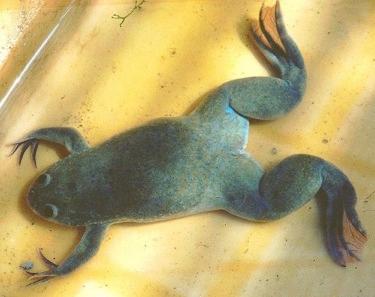African Clawed Frog
-
Scientific Name
Xenopus laevis - Visit ITIS for full scientific classification.
-
Description
 African Clawed Frog. © Michael Linnenbach (commons.wikimedia.org)
African Clawed Frog. © Michael Linnenbach (commons.wikimedia.org)- Can grow 2 to 5 inches long.
- They have a flattened body, and small, round, lidless eyes sitting on top of it's small head.
- Smooth skin, usually an olive brown color, with spots.
- They have 4 long, slim, un-webbed fingers on the front feet.
- The hind feet have 5 fully webbed toes with the inner three toes ending in a black claw.
- Xenopus are the only frogs with claws.
- They have no external ears or tongue.
- The tadpoles are translucent and have whisker-like tentacles on either side of the mouth.
-
Habitat
- Extremely adaptable creatures, found in a wide range of habitats, both natural and man-made.
- Can withstand extreme environmental conditions, including changes in pH, temperature, salt levels, and nutrient levels.
- They require water for reproduction, but can travel across land to find new habitats.
- Can go into a type of dormancy, burrowing itself in the sediment to survive dry conditions.
- Prefers still waters of ponds and slow-flowing streams, but can also live in flowing water.
-
Invasion Pathways and Distribution
- Introduced to the U.S. for pet and aquarium trade.
- Also used in laboratories across the globe.
- They continue to spread when they escape or are released from research facilities, aquariums, or by pet owners.
- They can spread naturally by swimming through rivers and streams, traveling over land, and can be carried by water flow during flood events.
- Native to southern Africa.
- See USGS for a map of current U.S. distribution.
-
Life History
- They can live a long time, with the oldest record being 30 years of age.
- Mating can occur anytime of year but peaks in the late spring.
- Mating occurs in still water and is triggered by a sudden increase in water level and nutrients.
- Eggs are usually deposited over aquatic plants or rocks.
- Tadpoles swim with their head down and feed on small animals (plankton) in the water column.
-
Impacts
- Consumes almost anything it comes across including invertebrates, fish, and tadpoles.
- Eats, and outcompetes native frogs.
- Can spread parasites and diseases, including a potentially fatal skin disease (Chytridiomycosis) to native frog species.
- Highly adaptable, can tolerate sewage and salty water.
- Fierce predator with claws, teeth and toxins on skin, able to consume prey larger than themselves.
-
References and Useful Links
For references by category and links to other useful AIS sites see our Learn More page.

